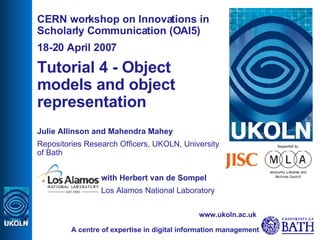
Object models and object representation
- 1. CERN workshop on Innovations in Scholarly Communication (OAI5) 18-20 April 2007 Tutorial 4 - Object models and object representation Julie Allinson and Mahendra Mahey Repositories Research Officers, UKOLN, University of Bath with Herbert van de Sompel Los Alamos National Laboratory A centre of expertise in digital information management www.ukoln.ac.uk
- 3. Overview and introduction Julie Allinson
- 13. Exploring options for metadata modelling Julie Allinson
- 19. Metadata semantics diagram this is very basic! … over-simplified from the Dublin Core Abstract Model http:// dublincore .org/documents/abstract-model/ value property resource description 1 0..n 1..n 1 describes statement statement statement statement
- 23. A metadata framework? Abstract Model Metadata Vocabularies Application profiles Metadata formats properties values Application models XML, RDF/XML, XHTML UK LOM Core, CanCore, RSLP Schema, AGRIS, Scholarly Works AP, NDLTD (theses), DDF-MXD, DiVA DCMI Abstract Model Embedded data models conforms to DCMES, MODS, LOM, ISO 19115, e-GMS, PREMIS, FOAF DCMI Type, DDC, LCSH, TGN, MARC Relator Codes
- 25. Some of the possible resources and relationships in our scenario publisher related materials version 1.0 electronic book image version 2.0 published proceedings pdf pdf 0..n is published by author author 0..n is created by 0..n see also 0..n has version 0..n is part of 0..n has part 0..n has format
- 28. Dublin Core Abstract Model summary record (encoded as HTML, XML or RDF/XML) description set description (about a resource (URI)) statement property (URI) value (URI) vocabulary encoding scheme (URI) value string language (e.g. en-GB) Slide courtesy of Andy Powell, Eduserv Foundation http://www.slideshare.net/eduservfoundation/the-dublin-core-abstract-model-a-packaging-standard syntax encoding scheme (URI)
- 32. the application model ScholarlyWork Expression 0..∞ isExpressedAs Manifestation isManifestedAs 0..∞ Copy isAvailableAs 0..∞ isPublishedBy 0..∞ 0..∞ isEditedBy 0..∞ isCreatedBy 0..∞ isFundedBy isSupervisedBy AffiliatedInstitution Agent
- 33. vertical vs. horizontal relationships ScholarlyWork Expression isExpressedAs Expression isExpressedAs Manifestation Manifestation isManifestedAs isManifestedAs hasFormat hasVersion hasTranslation hasAdaptation
- 34. Example properties ScholarlyWork: title subject abstract affiliated institution identifier Agent: name type of agent date of birth mailbox homepage identifier Expression: title date available status version number language genre / type copyright holder bibliographic citation identifier Manifestation: format date modified Copy: date available access rights licence identifier
- 35. Considering the scenario in DC
- 36. Multiple expressions, manifestations and copies scholarly work (work) version (expression) format (manifestation) copy (item) signed metadata doc institutional repository copy published proceedings no digital copy available (metadata only) e-book copy institutional repository copy pdf conference repository copy institutional repository copy pdf xml print copy pdf2 institutional repository copy Accepted MS Version 2.0 Author’s Submitted MS Version 1.0 Translation (Spanish)
- 39. Considering the scenario in MODS <mods> records for each version <relatedItem> sub-element used within a <mods> description for see also, has part, is part of relationships published proceedings e-book copy conference repository copy Accepted MS Version 2.0 Author’s Submitted MS Version 1.0 Translation (Spanish) <modsCollection> can be used to wrap together several <mods> records
- 43. Data model Slide courtesy of Mogens Sandfaer, Tech nical Knowledge Center of Denmark An article in the journal by the author presented at the conference published by from the project
- 46. Content packaging standards Mahendra Mahey and Herbert van de Sompel
